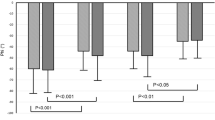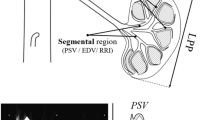Abstract
Elevated arterial pulsatility is a common risk factor for cerebrovascular disease and chronic kidney disease (CKD), which suggests that the brain and kidneys may have similar hemodynamic profiles. The objectives of this study were twofold: 1) to compare and contrast the cerebral and renal blood flow parameters in adults without CKD (hereafter, non-CKD adults) and CKD patients and 2) to determine the common predictor(s) of cerebral and renal hemodynamics among pressure pulsatility and several cardiovascular risk factors. In 110 non-CKD adults and 66 CKD patients, cerebral and renal blood flow velocity (BFV) were measured by transcranial Doppler and Duplex ultrasonography, respectively. Pulsatile hemodynamics were assessed by the pulsatility (PI) and resistive (RI) indices. Aortic pulse pressure was measured by tonometry. Compared with non-CKD adults, CKD patients showed greater pulsatility of the BFV (i.e., systolic minus diastolic BFV), PI, and RI in the kidneys but not the brain. However, the cerebral and renal PI and RI values were strongly correlated in both non-CKD adults (both PI and RI values: rs = 0.695) and CKD patients (both PI and RI values: rs = 0.640) (all P < 0.001). Multiple linear regression analysis further demonstrated that the cerebral and renal PI and RI associations remained significant after adjustment for potential covariates (e.g., age, sex, the presence of CKD). The aortic pulse pressure was a significant predictor for both cerebral and renal PI and RI values. Collectively, our findings suggest that CKD patients have higher renal flow pulsatility, which is strongly and independently associated with cerebral flow pulsatility and aortic hemodynamics.
This is a preview of subscription content, access via your institution
Access options
Subscribe to this journal
Receive 12 print issues and online access
$259.00 per year
only $21.58 per issue
Buy this article
- Purchase on Springer Link
- Instant access to full article PDF
Prices may be subject to local taxes which are calculated during checkout

Similar content being viewed by others
References
Toyoda K, Ninomiya T. Stroke and cerebrovascular diseases in patients with chronic kidney disease. Lancet Neurol. 2014;13:823–33.
Lu R, Kiernan MC, Murray A, Rosner MH, Ronco C. Kidney-brain crosstalk in the acute and chronic setting. Nat Rev Nephrol. 2015;11:707–19.
Bugnicourt JM, Godefroy O, Chillon JM, Choukroun G, Massy ZA. Cognitive disorders and dementia in CKD: the neglected kidney-brain axis. J Am Soc Nephrol. 2013;24:353–63.
Lau WL, Huisa BN, Fisher M. The cerebrovascular-chronic kidney disease connection: perspectives and mechanisms. Transl Stroke Res. 2017;8:67–76.
Toyoda K. Cerebral small vessel disease and chronic kidney disease. J Stroke. 2015;17:31–37.
O’Rourke MF, Safar ME. Relationship between aortic stiffening and microvascular disease in brain and kidney: cause and logic of therapy. Hypertension. 2005;46:200–4.
Williams LR, Leggett RW. Reference values for resting blood flow to organs of man. Clin Phys Physiol Meas. 1989;10:187–217.
Ito S, Nagasawa T, Abe M, Mori T. Strain vessel hypothesis: a viewpoint for linkage of albuminuria and cerebro-cardiovascular risk. Hypertens Res. 2009;32:115–21.
Hashimoto J. Central hemodynamics and target organ damage in hypertension. Tohoku J Exp Med. 2014;233:1–8.
Mitchell GF. Effects of central arterial aging on the structure and function of the peripheral vasculature: implications for end-organ damage. J Appl Physiol. 2008;105:1652–60.
O’Rourke MF, Hashimoto J. Mechanical factors in arterial aging: a clinical perspective. J Am Coll Cardiol. 2007;50:1–13.
Webb AJ, Simoni M, Mazzucco S, Kuker W, Schulz U, Rothwell PM. Increased cerebral arterial pulsatility in patients with leukoaraiosis: arterial stiffness enhances transmission of aortic pulsatility. Stroke. 2012;43:2631–6.
Hashimoto J, Ito S. Central pulse pressure and aortic stiffness determine renal hemodynamics: pathophysiological implication for microalbuminuria in hypertension. Hypertension. 2011;58:839–46.
Levey AS, de Jong PE, Coresh J, El Nahas M, Astor BC, Matsushita K, et al. The definition, classification, and prognosis of chronic kidney disease: a KDIGO Controversies Conference report. Kidney Int. 2011;80:17–28.
Tatu L, Moulin T, Bogousslavsky J, Duvernoy H. Arterial territories of the human brain: cerebral hemispheres. Neurology. 1998;50:1699–708.
Aaslid R, Markwalder TM, Nornes H. Noninvasive transcranial Doppler ultrasound recording of flow velocity in basal cerebral arteries. J Neurosurg. 1982;57:769–74.
Kosaki K, Tarumi T, Sugawara J, Tanahashi K, Kumagai H, Matsui M, et al. Renal hemodynamics across the adult lifespan: Relevance of flow pulsatility to chronic kidney disease. Exp Gerontol. 2021;152:111459.
Hashimoto J, Ito S. Aortic blood flow reversal determines renal function: potential explanation for renal dysfunction caused by aortic stiffening in Hypertension. Hypertension. 2015;66:61–67.
Aribisala BS, Morris Z, Eadie E, Thomas A, Gow A, Valdes Hernandez MC, et al. Blood pressure, internal carotid artery flow parameters, and age-related white matter hyperintensities. Hypertension. 2014;63:1011–8.
Xu TY, Staessen JA, Wei FF, Xu J, Li FH, Fan WX, et al. Blood flow pattern in the middle cerebral artery in relation to indices of arterial stiffness in the systemic circulation. Am J Hypertens. 2012;25:319–24.
O’Neill WC. Renal resistive index: a case of mistaken identity. Hypertension. 2014;64:915–7.
Kosaki K, Kamijo-Ikemori A, Sugaya T, Tanahashi K, Kumagai H, Sawano Y, et al. Urinary liver-type fatty acid-binding protein is associated with subendocardial viability ratio in middle- and older-aged adults. Clin Exp Hypertens. 2018;40:244–50.
Kosaki K, Sugawara J, Akazawa N, Tanahashi K, Kumagai H, Ajisaka R, et al. No influence of lower leg heating on central arterial pulse pressure in young men. J Physiol Sci. 2015;65:311–6.
Horio M, Imai E, Yasuda Y, Watanabe T, Matsuo S, et al. Developing the Japanese equation for estimated GFR. GFR estimation using standardized serum cystatin C in Japan. Am J Kidney Dis. 2013;61:197–203.
Matsuo S, Imai E, Horio M, Yasuda Y, Tomita K, Nitta K, et al. Revised equations for estimated GFR from serum creatinine in Japan. Am J Kidney Dis. 2009;53:982–92.
Mogi M, Horiuchi M. Clinical interaction between brain and kidney in small vessel disease. Cardiol Res Pr. 2011;2011:306189.
Zhang CY, He FF, Su H, Zhang C, Meng XF. Association between chronic kidney disease and Alzheimer’s disease: an update. Metab Brain Dis. 2020;35:883–94.
Roher AE, Garami Z, Tyas SL, Maarouf CL, Kokjohn TA, Belohlavek M, et al. Transcranial doppler ultrasound blood flow velocity and pulsatility index as systemic indicators for Alzheimer’s disease. Alzheimers Dement. 2011;7:445–55.
Tarumi T, Ayaz Khan M, Liu J, Tseng BY, Parker R, Riley J, et al. Cerebral hemodynamics in normal aging: central artery stiffness, wave reflection, and pressure pulsatility. J Cereb Blood Flow Metab. 2014;34:971–8.
Acknowledgements
We thank each of the study participants for their effort and time in contributing to the study. Additionally, the authors are grateful to the members of our laboratory (University of Tsukuba) and Ms. Michiru Hotta (University of Tsukuba) for their technical assistance.
Funding
This work was supported in part by a Grant-in-Aid for Scientific Research KAKENHI from the Ministry of Education, Culture, Sports, Science, and Technology, Japan (grant number 19H03995) and the MEXT Leading Initiative for Excellent Young Researchers Grant Number JPMXS0320200234.
Author information
Authors and Affiliations
Contributions
KK: Conceptualization, Investigation, Formal analysis, Writing - original draft, Funding acquisition, Project administration. TT: Conceptualization, Writing - review & editing. SM: Investigation. MM: Investigation. JS: Writing - review & editing. TS: Writing - review & editing. MK-o: Writing - review & editing. CS: Writing - review & editing. KY: Writing - review & editing. KO: Supervision, Writing - review & editing. SM: Funding acquisition, Supervision, Writing - review & editing.
Corresponding author
Ethics declarations
Conflict of interest
The authors declare no competing interests.
Additional information
Publisher’s note Springer Nature remains neutral with regard to jurisdictional claims in published maps and institutional affiliations.
Supplementary information
Rights and permissions
About this article
Cite this article
Kosaki, K., Tarumi, T., Mori, S. et al. Cerebral and renal hemodynamics: similarities, differences, and associations with chronic kidney disease and aortic hemodynamics. Hypertens Res 45, 1363–1372 (2022). https://doi.org/10.1038/s41440-022-00944-x
Received:
Revised:
Accepted:
Published:
Issue Date:
DOI: https://doi.org/10.1038/s41440-022-00944-x
Keywords
This article is cited by
-
Association of renal resistive indices with kidney disease progression and mortality
BMC Nephrology (2023)



